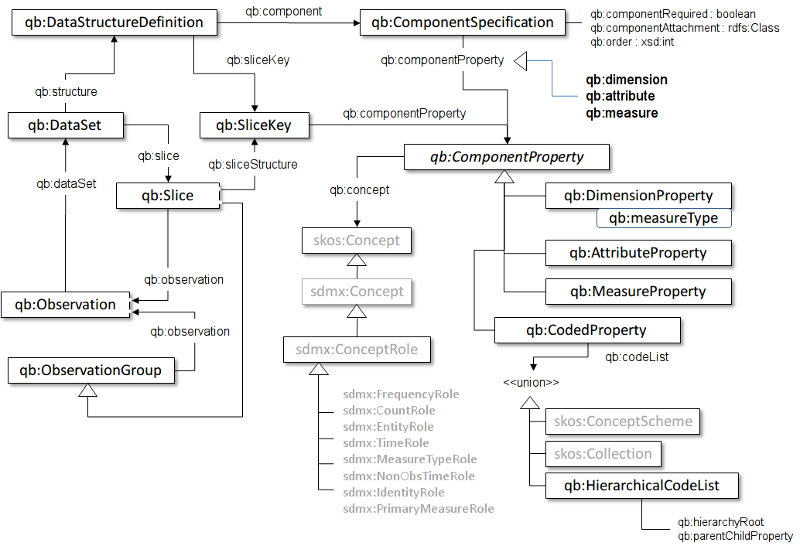Are you still interested in this? I'm thinking on adding multiple backend support to CubesViewer.
Open VladimirAlexiev opened 7 years ago
Are you still interested in this? I'm thinking on adding multiple backend support to CubesViewer.
Still interested, and we may be able to contribute some development through the BigDataGrapes project. It's about agricultural observations data that will use both QB and Geospatial components (similar to QB for Earth Observation, https://www.w3.org/TR/eo-qb/).
@jjmontesl wrote: I have similar projects: ETL tools and stuff built to import Spanish and Eurostat data. It'd be nice to talk about that at some point.
QB has been widely used to represent statistical data. Excerpt from a report I wrote : QB incorporates an OLAP data model and statistical classifications following SDMX. There is a number of statistical datasets available as RDF, including:
It lists two QB viewers, and then CubeViewer, which is much more powerful than those.
QB https://www.w3.org/TR/vocab-data-cube/ includes powerful OLAP metadata called qb:DataStructureDefinition and qb:SliceKey. The overall structure of the ontology is this:

@jjmontesl thinking on adding multiple backend support to CubesViewer
From the other discussion it seems that Cubes has multiple backend support but maybe it's not the best way forward? Seems you've already determined that the better engineering approach is to add such support to CubesViewer instead?
The reason I mentioned that is because CubesViewer needs multiple backend support anyway as I'd wish to add a local CSV/Tabularin any case, and perhapsp MDX in the future. From that point of view, it eases the path to integrate W3C Cube RDF.
But I'm not quite sure of the better engineering approach to this. On one hand, I'm not sure exactly I understand what you have in mind in terms of supporting QB. I have no experience with it and I'm not even sure what the possibilities are (I understand CubesViewer can consume W3C Cube schemas, but I'm not sure about how data is published/consumed).
@jjmontesl http://estatwrap.ontologycentral.com/page/ei_bsco_m is an example RDF QB dataset. At the bottom there are links for viewing it as a table, and downloading it as:
<ei_bsco_m.rdf#dsd>
a qb:DataStructureDefinition ;
qb:component [ qb:attribute estat:freq ] ;
qb:component [ qb:attribute estat:geo ] ;
qb:component [ qb:attribute estat:obs_status ] ;
qb:component [ qb:attribute estat:timeformat ] ;
qb:component [ qb:dimension dcterms:date ] ;
qb:component [ qb:dimension estat:indic ] ;
qb:component [ qb:dimension estat:s_adj ] ;
qb:component [ qb:dimension estat:unit ] ;
qb:component [ qb:measure sdmx-measure:obsValue ] ;
foaf:page <ei_bsco_m.rdf> .Note: I'm not sure why qb:attribute estat:geo: I think that should be qb:dimension since the geo (refArea) is surely a dimension of the observation.
If you look at the data, it consists of a bunch of nodes like this:
[ a qb:Observation ;
estat:geo <dic/geo#SE> ;
estat:indic <dic/indic#BS-PT-NY> ;
estat:s_adj <dic/s_adj#SA> ;
estat:unit <dic/unit#BAL> ;
dcterms:date "2016-11" ;
qb:dataSet <id/ei_bsco_m#ds> ;
sdmx-measure:obsValue 27.7
] .All dimensions and the measure are present in each observation. On the other hand the attributes freq obsStatus timeformat are optional, and are not present.
Is anyone else interested in Cubes support for the W3C Data Cube (QB) RDF data model https://www.w3.org/TR/vocab-data-cube/? I am particularly interested in supporting W3C Cube in CubesViewer, but as https://github.com/jjmontesl/cubesviewer/issues/70 shows, the preference is to add such support in Cubes, rather than the presentation layer (CubesViewer).
Cheers!